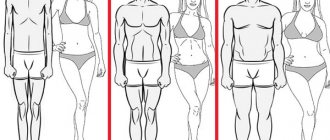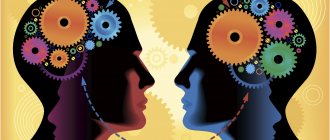Do you know that by understanding your type of perception (who you are: visual, auditory, kinesthetic, digital) you can increase the quality and speed of your learning and be able to convey your thoughts to a person with high accuracy? How to determine the types of information perception and how to use this knowledge in communication and learning will be discussed in detail in this article.
A ten-year-old child who was considered completely incapable of learning was brought to a wise teacher. Parents complained that no matter how hard they tried, they could not teach their son the simplest arithmetic. No matter how hard they tried to fold sticks, apples, or point with their fingers, nothing came out. He couldn't learn to add and subtract. The teacher talked to the boy for a few minutes. Then he asked his parents to sit aside while he taught their boy to count. Then the teacher asked the boy to stand up and jump over the pebbles. At first the boy simply jumped over the stones. Then the teacher said: “Look, do one jump, then a second, and then jump twice more. How many times did you jump in total?” And suddenly the boy answered - 4. Then the boy jumped and counted even more, in one day he mastered arithmetic, which ordinary children master in six months. The parents sat with their mouths open.
Why was this possible? The teacher was wise. He understood that this boy needed to be taught a lesson in such a way that he would be able to perceive it . He didn’t just hear, but perceived it in the way that was most understandable to him.
Today we will talk about what types of perception there are, and how understanding the types of perception of information helps in relationships and learning. And also about how to determine your type of perception.
In the simplest approximation, there are four types of information perception: visual, auditory, kinaesthetic, digital.
Channels of perception: visual, auditory, kinesthetic, digital
A person perceives information through the main five channels: visual, auditory, tactile, gustatory, olfactory. And after perception, the information is processed in our head, and the interesting thing is that it is processed on the basis of one prevailing system .
There are four main types of sensory systems:
- Visual. When the visual information processing system is dominant: shape, location, color.
- Auditory. The auditory information processing system is dominant: sounds, melodies, their tone, volume, timbre, purity
- Kinesthetic. Sensory information is dominant: touch, taste, smell, sensation of textures, temperature
- Digital. Associated with the logical construction of internal dialogue.
One should not think that the dominance of one means the weakness of the other. It’s just that one of the systems is most often the starting, leading one. It is the leading system that launches the thinking process and becomes the impetus for other mental processes: memory, representation, imagination.
For example, you are told, “Imagine the soft fur of a cat.” In order to visualize fur, you must first imagine a cat, and only then remember how soft its fur is. The auditory person first imagines the sounds of a cat (purring, meowing), and then can remember other sensations. The kinaesthetic sense immediately senses the touch of fur, and only then the visual image. Digital needs to say cat to himself and, after internal speech, imagine the image of a cat and fur.
Each of us sees the image of a cat in our heads, but for some it pops up immediately, and for others through their dominant system. The trigger system helps quickly translate a stimulus into images in our brain. That is why understanding your leading system allows you to individually and accurately create the principle of perception and memorization of any information.
Human representational system
To begin with, it should be recalled that representation should be understood as the process of representing and expressing certain experiences (thoughts, ideas, etc.) by a person. And a person, receiving information coming to him from the outside world, always relies on his senses. The human body is equipped with a huge number of sensitive receptors, which are the only way to receive information. To put it simply, all human experience is formed by the following sensations (modalities): visual, auditory, gustatory, olfactory and tactile. Besides them, there are others, but they play a secondary role. These modalities are called representational systems in NLP.
Receiving information through our senses, the brain encodes it and then represents it in the form of corresponding data, feelings and emotions, even a small part of which can accommodate a whole range of possible meanings. And a person already evaluates and systematizes these data and values. In short, this is how the process of perception works. But here we should take into account the main presupposition (truth that is not subject to discussion) of NLP - “The map is not the territory,” where the map is a person’s perception of reality, and the territory is objective reality itself.
It turns out that the way a person perceives the information received has only a subjective meaning, not reflecting the objective state of affairs. Each person has his own map, which is the basis of his perception, and this map, due to its individuality, will never become a reflection of the truth. But, knowing that each person has his own map, you can successfully use this, which, in turn, allows you to understand people on a deeper level and convey information in the form in which it will be perceived as accurately as possible. You can also influence a person’s map, thereby changing it.
In general, to be more specific, knowing about a person’s map and his peculiarities of perception, as well as about his map and his peculiarities, you can maximize the level of mutual understanding with others and make any communication as effective, mutually beneficial and productive as possible. And one of the main ways to influence oneself and others is precisely communication based on representative systems. We will talk about them further.
How to determine the types of information perception? Test to determine the type of perception
There are several ways to determine your type of perception and find out who you are: auditory, visual, kinesthetic, digital. Let's look at a few.
1. Self-observation. Look, what do you use most often during mental activity? How are your thoughts organized? Vivid pictures and images (visual), sensations (kinesthete), sounds and intonations (auditory), inner speech, logical connections, meanings (digital).
2. Below is a small list of words . After reading, try to understand what was the first thing that came to your mind, with what element did the idea begin? And what happened later?
- Soft touch velvet
- Musician playing violin
- Medicine
- Airplane taking off
If the first thing your idea started with is a picture, an image, then most likely you are a visual person. If the image began with sounds, and only then pictures were presented, then you are an auditory learner. If you needed to physically imagine how objects are located or you quickly developed bodily sensations - kinesthetic, and if you needed to say a word to make it appear - digital.
3. Take a short psychological test using the method “Diagnostics of the dominant perceptual modality by S. Efremtsev“
You can download it directly and, by answering the questions, determine your type of perception. Verification test: visual, auditory, kinesthetic, digital
4. Observe yourself and note what type of short-term memory is most developed for you? What do you grasp quickly and easily: pictures, sounds, sensations, logical connections? What is easier for you to remember?
5. People of each type of perception use in their speech certain phrases and expressions that are characteristic specifically of their leading, triggering system. However, I do not recommend relying on this particular test to determine what type you are. It can give an error in a number of cases when a person has trained himself to communicate in a certain way, use this method only as a complement to the above methods.
How can you determine who you are: visual, auditory, kinaesthetic, digital by speech?
Carefully monitor your speech and write down exactly the phrases that you use to indicate your opinion and your actions. Most often, a person of a particular type of perception uses phrases characteristic of this modality.
Visual
Uses words and phrases related to visual actions : I didn't see, I saw, I noticed, I think it was colorful and great, it looks, focus is concentrated, contrast, perspective, you see.
Audial
They often use phrases with auditory phrases : I can’t understand what you’re saying; didn't hear; I heard it; I recently heard; glad to hear from you; I heard it; the idea sounds tempting.
Kinesthetic
This type of perception is characterized by phrases that show their emotional and bodily responses: I can’t stand it; it's disgusting; it is so sweet; goosebumps; so pleasantly warm; it was a powerful experience. Often their nonverbal signs are very indicative; facial expressions and gestures are telling and reflect the state and emotions of a person, even if there are not many nonverbal signs themselves.
Digital
Digitals pay attention to logic and connections. A specific set of words is not typical for them: phrases of auditory and kinesthetic types may appear. Digital people often ask: what is the point of this; I don’t understand how this is connected; I would like to bring everything into a system; we need to streamline this somehow. However, such expressions are typical of most types with a good sense of organization. Therefore, identifying digital from speech must be done with great care.
Each type has its own characteristics that affect its perception of surrounding information, any educational processes, and interaction with other people. Let us analyze the characteristics of people of different types of perception.
Types of representational systems
NLP distinguishes several main representative systems, each of which receives information only in its own way, and then activates certain behavioral mechanisms. This whole process is controlled by the human central nervous system. For example, when we see something, the brain transmits what we perceive to us in the form of an image. When we hear something, the brain transforms it into sounds. Some internal sensations turn into feelings and emotions.
And then, when we remember any information, our brain sends a memory signal, and the memory is expressed in approximately the same form in which it was stored. It is on these principles that work with representative systems is based.
It should also be noted that there is a direct relationship between representative systems and the mental and physiological characteristics of a person, based on the analysis of which it is possible to determine a person’s personality type and its inherent traits. So, let's consider the types of representative systems.
Visual representational system
The visual representational system is based on the perception of visual images. People with such a system (visuals) organize their vision of reality through what they look at. What such people see and the pictures that arise in their imagination has a direct impact on their emotional state and inner world.
SIGNS.
You can identify a visual person by a straightened neck/back, as well as by an upward gaze. His breathing is shallow and, in most cases, chesty. When perceiving an image, visual learners may hold their breath for a moment until the picture takes shape. Their lips may be pursed and appear thin, and their voice is often loud and high-pitched. Any experience is remembered by visual people in the form of pictures and images, so when they have to take in someone’s speech for a long time or just listen to something, they begin to get bored, and the noise itself often disturbs them. When communicating with such people, you need to provide visual support for your speech. In percentage terms, visual learners account for 60% of all people.
APPEARANCE.
Visuals, as a rule, have a thin build, tall stature and a slightly elongated waist. Correct posture is often maintained. When interacting with them, it is advisable not to block their view of the place where they are.
Auditory representational system
The auditory representational system is based on the perception of sounds. People with the presented system (auditory learners) perceive information through the process of listening. All information is perceived and remembered by them, mainly in the form of sound impressions.
SIGNS.
You can recognize an auditory person by their eyes that often move in different directions. The breathing is rhythmic and even, but reflecting his internal experiences. If you ask such a person to describe some of his experiences, then, first of all, he will think about how to express it in the form of sound. The auditor speaks for a long time and a lot, expressing his thoughts very clearly. However, his speech can be very impulsive. Often dominates the conversation and often tires. He is particularly sensitive to sounds and often talks to himself. When communicating with an auditory speaker, you need to try to structure your speech more competently and accurately. As a percentage, auditory learners account for about 20% of all people.
APPEARANCE.
The body type of most auditory people is somewhere between thin and obese people. During a conversation, they often gesture and point to the ear area, and also lean forward, as if trying to be closer to the person with whom they are communicating. But when sounds arise in their own consciousness, on the contrary, they will deviate back. They monitor the rhythm of their speech and the timbre of their voice.
Kinesthetic representational system
The kinesthetic representational system is based on the olfactory-tactile channel of information. Such people (kinesthetics) really love tactile contact. Any experiences, emotions and sensations are best perceived by them if they have the opportunity to touch something and feel it physically.
SIGNS.
You can recognize a kinesthetic person in a person, first of all, by his eyes: his gaze is often directed “down to the right.” The breathing of a kinesthetic person is abdominal and deep, but depending on the sensations he experiences, it will change. The lips are, in most cases, soft and full, and the tone of the voice is low, deep, sometimes hoarse and slightly muffled. During a conversation, a kinesthetic person will speak slowly, taking long pauses while searching within themselves for relevant information. Kinesthetic learners account for about 20% of all people.
APPEARANCE.
If the perception of kinesthetics is directed inward, then, most likely, outwardly this will be expressed in the fullness and roundness of the body. If the perception is directed to the outside world, then this will reflect strength and muscularity. Most kinesthetics move rather slowly. To encourage them to be active, you often need to show physical contact - clap or encourage them in some way. And when communicating, it is recommended to be closer, because Kinesthetic people prefer intimacy.
Digital representational system
The digital representative system is based on subjective-logical perception and comprehension. People using this system (digitals) function at a meta-level of consciousness, which includes data received through the visual, auditory and kinesthetic systems. Any information they perceive is reflected in all manifestations of the systems discussed above.
SIGNS.
You can understand that a person is digital both by the movement of his eyes, which can often be directed downward to the left or move from side to side, and by his thin and compressed lips. His breathing is uneven and characterized by short sighs. If we talk about posture, then the shoulders are usually straightened, the neck is straight, and the arms are crossed on the chest. The voice often sounds monotonous, and the person speaks as if “automatically.” Only a small percentage of all people fall into the digital category.
APPEARANCE.
Considering that people with a digital representational system include the properties of people with visual, auditory and kinesthetic systems, it is quite difficult to determine their exact external characteristics. We can only say that outwardly they may look completely different.
In addition to the above, there are also two other representative systems - olfactory (olfactory) and gustatory (gustatory). But these systems are very poorly distributed and people who have them are quite rare. These systems are observed mainly in those people who are deaf or blind. For these reasons, they are almost never considered in NLP.
To summarize this section, it is very important to note that there are no people with any one representative system. In real life, people always (consciously or subconsciously) change them based on the situation. Depending on what is perceived at a given moment in time, a person can process one manifestation visually, and approach the second from an auditory position, and vice versa.
Speaking about the effectiveness of defining representative systems, it must be said that one of the most important laws of NLP is the following: what a person says when describing any of his experiences can have not only a metaphorical meaning, but also literally reflect the processes occurring in his mind during the representation of data .
It follows from this that any representative system is directly related to speech manifestation. For example, if a person tells you: “I imagine this the same way as you,” then most likely he feels the need for visual images when communicating. And in order to “join” it, you need to visualize a picture of what is being discussed and express it verbally.
If a person says: “I feel with my whole being.... ", then continuing a conversation with him, being tuned to the position of an auditory or visual person, will be extremely ineffective, because no attunement will occur. Here you need to talk using words that are close to sensations and physical contact. Only in this case will it be possible to find mutual understanding.
The words that a person most often uses during a conversation, based on sensations and reflecting his perception, are called predicates (see below in the text). Skillful use of predicates facilitates rapid attunement with another person. It is this attunement, i.e. adjusting to the other person, joining their perception, map, worldview and model of representation of experience is most important in establishing a mutual connection. After all, when we speak to a person in “his” language, we become closer to him and closer to him. And people, as a rule, enjoy communicating with people like them.
But, as already noted, for effective communication it is important not only to know about representative systems, but also to be able to determine the main one.
Visual, auditory, kinesthetic, digital in the learning process
If you study a lot, go to courses, trainings, read, then understanding your own type of perception will help you organize your own learning process with maximum benefit.
Visuals
The basis of their learning is visual information. For visual people, hearing and vision form a single whole, therefore, if such a person only heard the material (but did not see), then with a high degree of probability the information will be quickly forgotten. Visual learners instantly absorb all visual information, so it is most beneficial to use all methods and techniques for visually presenting the material:
- mind maps
- scheme
- graphs
- illustrations
- photos
- demonstration models
- experiments, experiments
Visual learners learn best through visual examples, where they see the material they are learning in real time. Primary memory is visual. They remember well the location of objects, paths, roads, and are well oriented in space. Some noise is not critical for a visual learner; he can concentrate in an environment of some noise and successfully study the material.
Read the article - What are mind maps. How to make a mind map
Visual learners perceive text information well and are able to quickly learn speed reading.
Audial
Uses the auditory perception channel as a trigger. Inner speech is moderately developed. They perceive lectures, music, conversations, and dialogues well. They clearly and effectively maintain the line of conversation and conversation; often it is during the conversation that they grasp the meaning of the material being studied. Silence is necessary when concentrating. If you are an auditory learner, then be sure to listen to lecture material and audio courses. Learn together with others, discussing the topic being studied, thinking out loud about the problem.
Kinesthetic
Receives information through actions and movements. He remembers any actions and practical exercises well. He perceives all information best through practical exercises and experiments, where he tests the information received with his own hands in practice. Information of a practical nature is especially well perceived: what moves and how, where to click.
It is important for kinaesthetic learners to feel, touch, smell, taste and fully experience the subject being studied. People of this type are very active, love and enjoy working. And they don’t like inaction. It is for kinesthetic learners that the saying “Movement is life” has a special meaning. It is very difficult for kinaesthetic people to maintain focus, they are easily distracted, it is difficult for them to sit still for a long time, or to do routine work.
Digital
They are well trained in all sciences that have strict logic and consistency: mathematics, physics, mechanics, technology. Such people often work in areas where there is a lot of research, mathematical and static processing, and programming. The main thing for digital is to understand the logic and connections in the material, to organize what is being studied into a system with clear cause-and-effect relationships. Therefore, during your studies, try to build the logic of the entire topic being studied. For this you can use:
- scheme
- mind maps
- compressed plans
- Personally compiled thesauri
Recommendations for using knowledge about a representational system
And at the end of the lesson, we provide several useful practical recommendations , which you can try and get results from in the very near future.
- First of all, define your leading representational system. Find tests to determine it (there are a lot of tests on the Internet) and take them, observe yourself, your thoughts during the day, reactions, ways of conducting dialogue. Mark the words that you often insert into your speech. This will help you get to know yourself better. You can then apply this knowledge when communicating with others and can guide those you communicate with on how to interact with you more effectively. You will also be able to find the methods of obtaining information and ways to relax that are most suitable for you. After all, nothing has such a beneficial effect on a person and his psyche as doing something to which he is initially predisposed.
- As you know, the vast majority of people in the world are visual people. Use this knowledge to your advantage: always, when communicating with new people, focus on those methods of influence that affect people with a visual representational system. Use more figurative expressions in your speech, give bright colorful examples, create pictures in people’s imaginations of what you are talking about. Also keep a certain distance from people, giving them room to see. Once you use pre-prepared techniques, you will be able to make the correct assessment with certainty and evaluate the effectiveness of your communication and impact. And if your predictions do not come true, you should resort to using other techniques.
- Having at least roughly defined the leading representative system of a person, try not to use predicate words that do not correspond to his type. What will be extremely effective for a visual learner will not be suitable for an auditory, kinesthetic learner, etc. If you find that what you say is not having the desired impact, then most likely you have defined the system incorrectly and you should resort to experimenting with new words.
- When communicating with people of each representational system, try to adjust the pace of your speech and the volume of your voice to them. With kinesthetic learners you should speak slowly and not very loudly, because... it fits their “characteristics.” This is necessary so that the information flows smoothly, otherwise they simply will not understand anything from your speech, even if they try very hard. It's a little easier with audio, because... they are subconsciously tuned to auditory perception and what you say will immediately fit into their minds. But here it is important to speak not too slowly and not too quietly, because... the original message will lose its momentum and you will have to start over. Visual learners generally do not perceive what is said to them very well. Therefore, regardless of the pace and volume of your speech, try to resort primarily to the use of visual characteristics. Better yet, show them what you are talking about - then the information will hit the nail on the head.
- Eyes very well reflect a person's thought processes, because... Controlling eye movements is a rare ability and few can boast of it. Knowing this fact helps not only to determine the leading representative system, but also to identify lies. Remember, a person who is uncomfortable will either always look away from yours and try to avoid it. Or, on the contrary, he will not look away, looking into your eyes, trying to seem overly honest. Observe which direction the person is looking when talking to you: very often, if a person is lying, he will look down to the left, conducting an internal dialogue with himself and, most likely, trying to come up with something. If a person looks up and to the right, it means that he is creating some kind of image in order to then voice it to you. Looking to the right, a person selects suitable phrases, and looking down to the right, a person feels some emotions determined by the context of your conversation. Such lie detection methods are often used by specialists in intelligence agencies.
- Knowledge about representative systems is very convenient to use when raising children , because a correctly identified leading system will help build a strategy for influencing the child, following which the process of upbringing itself will bring him only pleasure, arousing interest, and will not be a burden for the parent, because will happen easily and naturally. By influencing the child’s representative system, you can improve your performance in school, determine his predispositions and send him to the appropriate section, learn to explain complex things in a very simple and understandable language, and also avoid misunderstandings and, as a result, tense situations in the family.
- And, of course, the topic of the professional sphere of activity cannot be ignored. Knowing the leading representative system, for example, your boss, with whom your relationship is not going very well, you can change the situation to your advantage, solve pressing problems and even get a promotion or increase in salary. To do this, you need to learn how to express your thoughts as correctly as possible and convey them in such a way that they are extremely clear. Moreover, the boss himself may not even realize that he was directly influenced by you.
- The same applies to business: by influencing the representative systems of your colleagues and potential partners, you can resolve controversial issues to your advantage and conclude promising contracts , convincing people of the uniqueness of your project. Today, the heads of many successful companies and corporations use such knowledge from the field of NLP in managing their companies and interacting with partners and employees.
Based on all of the above, we can conclude that representative systems are an integral part of the personality of every person, and knowledge about them is a powerful, effective tool for improving communication with other people and one’s own life. The main thing is to put them into practice and hone your skills.
Visual, auditory, kinaesthetic, digital in communication
Visuals
“You meet people by their clothes...” the beginning of this famous proverb applies entirely to visual people. They attach significant importance to a person’s appearance and always pay attention to how a person looks, what clothes he is wearing, what facial features he has, how he moves.
When communicating, they can look into the eyes calmly and for a long time. Visual contact, inverted posture in communication, open postures are extremely important for the visual person. At the same time, they do not like to be close to their interlocutor and keep their distance. The main thing is to see well. Representatives of this type of perception quickly intuitively read the signals of body language and facial expressions, often without noticing it. Sometimes it seems to them that just by looking at them they know the thoughts of another person.
Read the article on nonverbal communication
If you need to impress a visual person, try to pay the most attention to external beauty. The environment, your clothes, gait, facial expressions, and gestures should be as inviting as possible. To prove your words, provide clear examples, graphs, drawings, and be sure to demonstrate your arguments using samples and experiments. Show a picture instead of numbers: visual learners will have difficulty understanding the difference between 1000 and 10,000, but a visual example of the difference will convince them in most cases.
Visual artists themselves are good storytellers. They can imagine amazingly vivid and detailed pictures and talk about them for hours.
Audial
A conversation with an auditory student is often very pleasant. Auditory learners themselves are demanding of their speech; they speak measuredly, with competent changes in intonation. It’s nice to listen to them, it’s nice to talk to the auditory. But auditory learners themselves are very demanding of the speech of their interlocutors; they cannot tolerate errors in speech, incomprehensible and distorted speech. It is absolutely forbidden to shout or raise your voice at auditory learners; this will lead to alienation of the person. Audials are always a pleasure to listen to; they are wonderful storytellers and no less wonderful interlocutors, who can understand at a glance by their intonation and manner of speech.
Kinesthetic
Kinesthetic learners are especially sensitive to spatial surroundings and distances between interlocutors. Close people are allowed into the personal zone, but people they don’t know well are kept at a distance. For kinesthetes, an invasion of their personal zone is offensive, and they begin to experience strong negative emotions. It is best to gain the attention and trust of the kinaesthetic through actions, joint affairs, and common activities.
If you have to remember something, it is better to write it or draw it yourself. Conversations and verbal evidence will make the least impression on a person of this type of perception. And the kinaesthetic always strives to touch and stroke close people. Physical contact is important to him.
Digital
They are insensitive in communication and rarely show emotions in public. Particular attention is paid to the semantic, substantive part of the conversation. Beautiful but empty speech is unpleasant to them. With digital, it is best to get to the point in a conversation, proving the logic and correctness of your words with numbers and facts.
Definition of the leading representational system
Despite the fact that a person perceives any information he receives with the help of all representative systems, he uses one of them much more often and more intensively than all the others. It is this system that is called leading. And in order to determine which system is it, there are several effective methods in NLP.
Firstly, you can take a special test to determine your leading representative system.
Test to determine the leading representative system
To get started, read these simple rules:
- When answering a question, choose the option that seems most preferable and comfortable for you in most life situations. If you don't like both options, then choose the least unattractive option.
- Due to the fact that some of our characteristics change throughout life, and the same person at 7 years old is different from himself at 30 years old, try to answer the questions from the point of view of yourself today. When given a choice in a hypothetical situation, respond as if the situation were recent and choose what you would have done in the last 1-2 years.
- The test can be taken several times, but we do not recommend doing this; it is better to choose a time when you can pass it carefully in one go.
- The test data will be recorded after you answer the last question and see confirmation of the end of the test. If you finish the test before the last question and close the page, the data will not be saved.
- The test can be taken any number of times, but remember that only the last one is saved. If you have already taken this test, a sign will appear in the left menu.
Statistics Full screen
Secondly, as mentioned above, any representational system is reflected in the movement of a person’s eyes, the pace of his speech, the timbre of his voice, his posture, neck position, gestures, arm and body movements, favorite poses, as well as body type.
These characteristics are important when you need to determine not your own representative system, but the system of another person (it is not always possible to ask everyone to take a test). To understand which system is leading, you only need to know the signs of each of them (see above in the text) and be able to identify them when communicating with people and observing them.
As an example, we can cite the eye positions characteristic of each system, called ocular access keys:
People with a leading visual representational system will have a defocused gaze directed straight ahead when visualizing; when forming a visual image, their gaze will be directed up and to the right, and if a person is remembering something, their gaze will be directed up to the left.
People with a leading auditory representational system will direct their gaze to the right when forming sound images, and to the left when recalling them.
People with a leading kinesthetic representational system will direct their gaze down to the right when experiencing bodily sensations and emotions, and down to the left when conducting internal dialogue.
And thirdly, because the determination of the leading perception system is carried out on the basis of observation of a person in the process of interaction with him; the analysis of his speech and the determination of the most frequently used predicate words, which we recently mentioned, should be carried out most carefully. Below are the predicates that are most typical for people to use each of the systems.
Visual system
- Nouns: perspective, aspect, picture, illusion, point of view, nuance, position, etc.
- Verbs: describe, imagine, look, clarify, manifest, observe, notice, show, display, illustrate, see, etc.
- Adjectives: wide, narrow, blurry, clear, open, distant, small, clear, foggy, etc.
- Statements: “I imagine”, “In my opinion”, “It seemed to me”, “You see”, “Shedding light”, “Bringing clarity”, etc.
Auditory system
- Nouns: intonation, timbre, voice, dialogue, whisper, echo, song, sound, tonality, symphony, harmony, conversation, conversation, etc.
- Verbs: discuss, listen, ask, call, remain silent, express, speak, expound, mumble, etc.
- Adjectives: unheard, deaf, silent, speaking, melodious, dumb, noisy, sonorous, loud, etc.
- Statements: “Saying differently”, “They set the tone”, “I want to hear”, “You can say”, “Mutting the dialogue”, etc.
Kinesthetic system
- Nouns: tension, heaviness, contact, load, breathing, movement, fatigue, vigor, weight, influence, etc.
- Verbs: touch, feel, sense, hit, squeeze, balance, perceive, move, etc.
- Adjectives: unbearable, sensitive, soft, immovable, heartfelt, hot, unbalanced, hardy, dumbfounded, etc.
- Statements: “I feel that”, “Influencing the situation”, “Holding on tightly”, “Carrying a heavy load”, “Let’s make an impact”, etc.
Naturally, these are not all words and expressions, identifying which one can determine the leading representative system of a person. In fact, there are a great many of them and there are countless different variations. It is important to simply learn to determine the basic line that a person adheres to in his statements.
Better yet, learn to compare these predicates with the physiological manifestations that characterize each of the systems. Then it will be much easier to draw a conclusion, and the likelihood of its accuracy will increase significantly.
But in addition to the above-mentioned features, which are worth observing when communicating with people, aspects of a person’s life and activity can also speak about a person’s predisposition to a particular representative system.
What else to pay attention when determining the leading representative system:
| ✔ | How a person describes his experiences, experiences, memories. |
| ✔ | What does a person like to remember most, what moments of his life do he remember more than others? |
| ✔ | A person’s appearance: is he neat, how good does the person look, what attention does he pay to his appearance. |
| ✔ | Favorite items. |
| ✔ | Favorite ways to spend time, interests, hobbies, hobbies. |
| ✔ | What does a person like most: watching movies, listening to music, reading books, playing sports. |
| ✔ | Favorite way to relax, i.e. What does a person do if he has a free minute? |
| ✔ | Preferred way to obtain new information: video, audio, books. |
| ✔ | Orientation in space. |
| ✔ | Desire to communicate by phone, Skype, email. |
| ✔ | The furnishings in the apartment and the interior of the room in which the person lives, etc. |
Moreover, all these indicators are important not only in relation to those people with whom you have to communicate at work or other everyday affairs, but also in relation to your loved ones and yourself. After all, identifying them will not only help you learn to communicate more productively, but will also have a huge positive impact on your own state and mood in everyday life, the inner world of dear people, the microclimate in the family and your attitude towards life in general.
Features of each type of perception
Visuals
The peculiarity of this type of people is that they are receptive to what is visible. They appreciate beauty in the surrounding space and do not tolerate disorder or dirt well. In the life of a visual person there are many ideas, dreams, dreams. They are often generators of ideas, since they can create completely unusual associations and connections in their imagination.
Audial
They perceive the world around them, paying especially close attention to sounds. They love music, melodies, and can often hum to themselves and hum songs. Sensitive and receptive to conversations, auditory people have acute hearing and good memory, especially auditory memory. They often choose as their occupation everything related to music, melodies, and oratory.
Kinesthetic
Kinesthetics are very sensitive to everything that happens around them. Their bodily and emotional sensations are closely intertwined. They love bodily comfort, the convenience of the surrounding space. Uncomfortable clothing or a thread tickling their neck can irritate a kinaesthete student. They love deep personal discussions, communication with emotional exchange, discussion of how others feel. For the kinesthete, touch has the deepest meaning and great value.
Digital
People of this type of perception are rarer. They tend to perceive the world around them through inner speech, through dialogue with themselves. Such people are primarily focused on the perception of meaning, logic, and consistency. Digital people always strive to understand and comprehend the essence of what is happening. They may be sensitive and vulnerable, but the world is interesting to them from the point of view of understanding meaning and logic, patterns. In a stressful situation, it is digitals that best maintain composure and calm, and can maintain clarity of thought and perception of the surrounding space.
Strictly speaking, the distribution of people into visual, auditory, kinaesthetic, and digital types is very simplified. In fact, each of these types can be mixed, or maybe with a different leading hemispheric system, which increases the number of options. But we'll talk about this later.
It will also be useful: materials on how to quickly work with books, audio and video information
Of course, in each of us there is no pure one type of perception, sometimes they are mixed, sometimes the type of perception is different in a calm and emergency environment, in different situations. But understanding your leading system will allow you to better assimilate any information, understand your interlocutor and better convey your thoughts to him. Understanding your type of perception (visual, auditory, kinesthetic, digital) will allow you to understand how to study specifically for you, taking into account your individual characteristics.
Read more about how to learn to study
All of this is definitely a useful skill to pay attention to.
Audials
Type of perception - Auditory
For the most part, they read information by ear. This audience can watch the video. Autoplay of videos with harsh sound irritates many people, but not auditory people, if the soundtrack is chosen well. Pure audio is rare, so usually on sites where podcasts are published there is text that duplicates the audio version. This helps to capture the attention of visitors with any type of perception. In the text it is worth using words related to the perception of information by ear. For example, “listen”, “let’s discuss”
What auditory learners will appreciate:
- Podcasts
- Dialogues in texts.
- Words associated with the perception of information by ear: “let's talk”, “listen”, “discuss”.
- Invitation to leave comments.
Sensations and feelings
A person of a kinesthetic type primarily experiences the world through sensations and feelings. Visual and auditory effects fade into the background for him .
In theoretical psychology, only proprioception . This is a set of signals coming from receptors in the skin, muscles, tendons, and joints.
They convey the basic sensations that arise during movement, contact with other objects, during changes in body position, etc.
Practical science considers this issue more broadly.
Kinesthetics includes the entire range of sensory experiences: touch, taste perception (sweet, salty, etc.), smells, thermoregulation, pain.
With the help of kinesthetic sensations, a person can analyze the position of his body or the movements performed by its individual parts, even with his eyes closed and the absence of sound signals.
During movements, signals are sent to the brain that are responsible for muscle tone and coordination.
Any movement is controlled by the brain. For this reason, loss of proprioceptive stimulation leads to motor disorders .
Kinesthetic cognition is directly related to vision. On the one hand, the individual visually determines distances using the sensations experienced.
On the other hand, in the absence of visual perception of reality, it is much easier to navigate in space if a familiar visual image is formed in the mind.
For example, when a person moves in a dark room, guided by the touch of his hands on surfaces, he unconsciously reproduces in his head a visual image of a familiar room.
Kinesthetic sensitivity plays a big role in skill development . The automated movements that people make are the result of the development of muscle memory.
Thus, in one’s own home, a person often does not use vision to turn on the light in the room. His hand automatically reaches for the switch, located in its usual place.
how to make a good first impression on a client
At a business meeting with a client, in addition to the main factors in forming the first impression, the interlocutor forms not only his opinion about you as a person, but also as a specialist and also evaluates your company. Let's figure out what criteria the client uses to form an impression of the company:
- logos, graphics, design
- advertising brochure
- Product Catalog
- souvenir products
- product samples (if available)
To make a competent impression on a person, you need to maintain a balance according to different criteria. Remember that customers evaluate the seller holistically. At the same time, one negative element can scare away the client and create a negative attitude. Before appearing “in front of” your interlocutor, check your condition:
- look at yourself in the mirror
- drink some water
- freshen your breath
- check your emotional state
- smile
Good luck with your work with clients!









